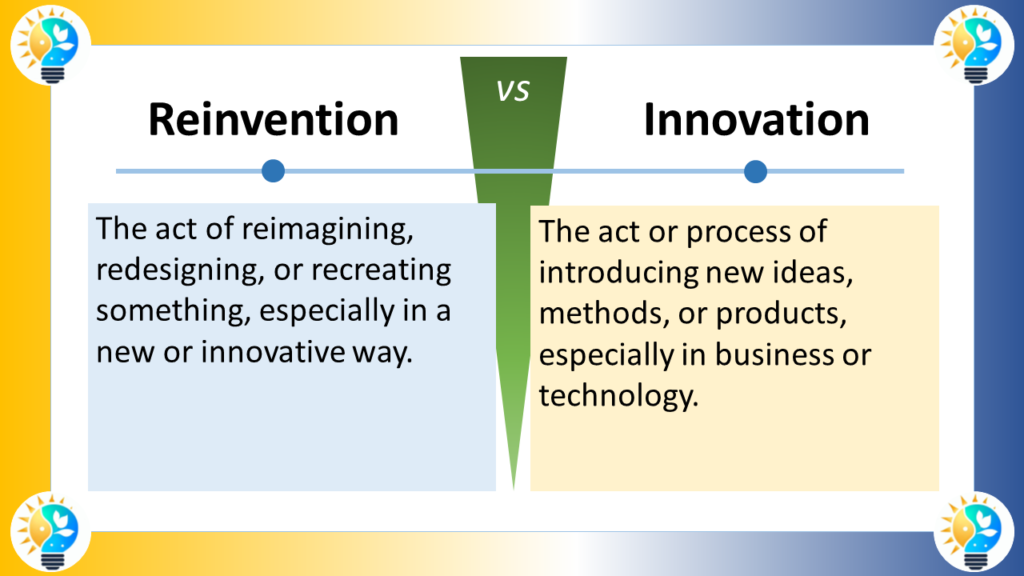The difference between reinvention and innovation lies in the approach and outcome related to change and development.
Reinvention involves taking something that already exists and transforming it, often radically, to give it a new form, function, or identity.
Innovation is about creating something completely new or significantly improving upon an existing product, process, or idea.

Definition
Reinvention
Reinvention is the process of changing something so significantly that it appears entirely new or is put to a different use.
- Characteristics of Reinvention:
- Transformation: Involves a fundamental change in appearance, form, or function.
- Adaptation: May update an existing concept to fit new conditions or opportunities.
- Identity Shift: Often results in a change in how the subject is perceived.
Innovation
Innovation entails the development and application of ideas that result in the introduction of new products, services, or methods, or substantial improvements to existing ones.
- Characteristics of Innovation:
- Novelty: Brings about something new or significantly improves on what’s currently available.
- Implementation: Involves putting a new idea into practice.
- Value Creation: Leads to new capabilities or benefits that were not previously possible.
More Synonyms on innovation, innovate and innovative
Innovation Terms

Innovation is considered as a driving force in progress.
It includes the introduction of novel ideas, methods, or products that bring positive change and advancement.
For more information about innovations, check our glossary
Relationship and Relevance
While reinvention and innovation both involve change, reinvention is often about reimagining or repurposing something that already exists, whereas innovation is about the birth of original ideas or breakthrough improvements. Both can lead to significant shifts in markets, industries, or personal lives and can sometimes overlap when an innovation so drastically changes the original concept that it could also be seen as a reinvention.
The key difference between reinvention and innovation is:
Reinvention refers to fundamentally changing or transforming something to create a new version or iteration, while maintaining some core elements. It involves rethinking and reimagining an existing product, service, or system to make it significantly different.
For example, a company reinventing its business model or a person reinventing their career would be considered reinvention. The core purpose or identity remains, but the approach is radically altered.
Innovation, on the other hand, is the introduction of something entirely new - a novel concept, product, service, or way of doing things that did not exist before. It goes beyond just changing the existing and creates something fundamentally different.
Innovations, such as the creation of the smartphone or the ridesharing model pioneered by Uber, disrupt existing industries and change the status quo in a significant way. They are not just incremental improvements, but transformative breakthroughs that are new to the world.
In summary, reinvention focuses on radically reshaping and redefining the current state, while innovation involves creating something entirely new that did not exist previously. Reinvention is about a major overhaul of an existing entity, while innovation is about introducing something completely novel.
Context for Using Each Term
- Reinvention is commonly used in personal, business, or product development contexts to describe a process of transformation or revitalization.
- Innovation is frequently associated with technological advancements, business models, and processes that introduce new ways of thinking or operating.
Example of Utilization
A company that takes an outdated business model and radically transforms its operations and strategy to remain competitive is engaging in reinvention. An organization that develops a new technology that revolutionizes communication or data processing is an example of innovation.
In essence, reinvention focuses on altering what is already there, often to give it a new life or purpose, while innovation is about creating new value through the introduction of something that did not exist before.
FAQ
Q1: Can reinvention be as impactful as innovation?
A1: Yes, successful reinvention can be just as impactful as innovation, especially when it breathes new life into established products or industries.
Q2: Is reinvention less risky than innovation?
A2: Reinvention can be less risky as it builds on existing concepts, but it still involves significant change and potential challenges.
Q3: How do companies decide between reinvention and innovation?
A3: Companies often assess their market position, available resources, and long-term goals to determine whether reinvention or innovation is more appropriate.
Q4: Can reinvention lead to innovation?
A4: Yes, the process of reinvention can sometimes lead to innovative breakthroughs or inspire entirely new ideas.
Q5: Are certain industries more prone to reinvention or innovation?
A5: While both strategies are used across industries, mature industries may lean more towards reinvention, while emerging tech sectors often focus on innovation.
- Innovation vs. Reform
- Model
- The Difference Between Innovation vs. Change
- Voices: Reformers vs. Innovators
- Difference Between Transformation and Innovation

